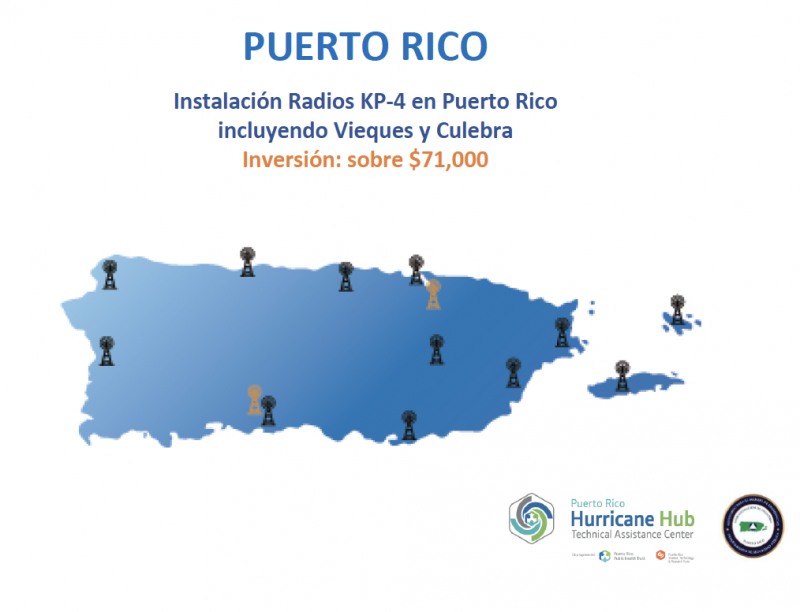
Hurricane Hub invests over $71,000 in KP4 radios to keep Puerto Rico communicated in case of disasters, emergencies, and power failures
Installation completed in all regions of the Emergency Management Division, including Vieques and Culebra
Friday, October 9, 2020. San Juan, Puerto Rico – An investment of over $71,000 made by the Puerto Rico Hurricane Hub (PRHH) – a program of the Puerto Rico Public Health Trust (PRPHT), both integrated to the Puerto Rico Science, Technology and Research Trust (PRSTRT) – to the Emergency Management and Disaster Administration Division (NMEAD) made possible the purchase and installation of KP4 radios, antennas and solar panels in the NMEAD Main Office and its 10 regions around the Island, including Vieques and Culebra. The objective of this initiative is to keep Puerto Rico communicated through all areas of this first response agency, to respond quickly to any emergency.
The official announcement was made in a virtual press conference during which a successful test was made, achieving communication through the KP4 system from the NMEAD office in San Juan and the island municipalities of Vieques and Culebra. These tests of KP4’s radios in Culebra, Vieques and San Juan were carried out by certified operators Alberic Medina, Urayoan Silva, Engineer Anthony Yrimia and José Estrada of the Puerto Rico Radio Amateurs Bank in the Telecommunications Bureau.
“We know that communication is vital in the event of a disaster and this equipment will serve to connect people and save lives,” said Leslie Maas-Cortes, director of the Puerto Rico Hurricane Hub. “The power grid is still vulnerable, and with the new reality of Puerto Rico’s earthquakes, the COVID-19 pandemic and the hurricane season underway, it is impossible for us to be cut off if an emergency arises,” she said. “This method of communication is not new, but it has proven to be effective over the years, so we understand that communications will be much more reliable and immediate. This is possible thanks to the National Network Public Health Institute (NNPHI) and the CDC centers.”, Maas-Cortes concluded.
The radios, popularly known as KP4, provide an alternate communication infrastructure that supports the current communication system. This type of communication has been proven to be a reliable communication method that prevails in an emergency.
For his part, Nino Correa, Commissioner of the Emergency Management and Disaster Administration Bureau, highlighted the importance of this project for Puerto Rico and assured that, “this communication system interconnected with all the emergency management zones will be very useful to maximize our work and will allow us to be more agile and precise when it comes to determining the personnel and resources for each situation or event that we have to attend,” he said.
Currently, there are close to 5,000 licensed amateur radio members in Puerto Rico, although about 2,000 are active. All users must be certified by the Federal Communications Commission (FCC). The mission of the radio amateurs is to help in emergency situations such as atmospheric events or cyber-attacks. They are trained and qualified to raise communication antennas in an emergency and communicate on two frequencies: HF (internationally) or VHF (locally). In the event of a crisis or disaster, KP4s update emergency management agencies on the Island, communicate with each other locally; and with people abroad to identify needs and channel assistance as required.
The equipment provided and installed by a Puerto Rican company Skytec Inc. will allow us to create a network of additional collaborators among all the radio amateurs that will maximize the capacity of communication and infrastructure resilient to a disaster. It was completed to be available in this Hurricane Season that extends until November 30th; and includes the purchase of equipment accessories, training and FCC certification for NMEAD personnel, so that they can make the best possible use of KP4 radios. Maintenance of the equipment will be the responsibility of the agency.
It should be noted, that this process had begun earlier this year with the purpose of having it ready for the start of the hurricane season, but due to the pandemic the work that culminated in the assembly of the KP4 radios in the municipalities of Culebra and Vieques was delayed. The assembly of this equipment in Vieques, in the month of October, coincides with the NMEAD’s “Tsunami Ready” Project for the coastal municipalities, with which the island municipality now also has an alarm system to alert residents of the possibility of a tsunami.
The Mayors of Vieques and Culebra, Victor Emeric Catarineau and William Ivan Solis respectively, participated in the testing of the equipment from the Emergency Management office of their respective municipalities and welcomed Operation KP4; recognizing that this communication system will keep them connected to Isla Grande and will allow them to provide a rapid response to their residents, in case of emergency.
For more information on the services of Hurricane Hub access our website
https://prsciencetrust.org/prhrh/ and/or request your training, free of charge, here: https://prsciencetrust.org/asistencia-tecnica